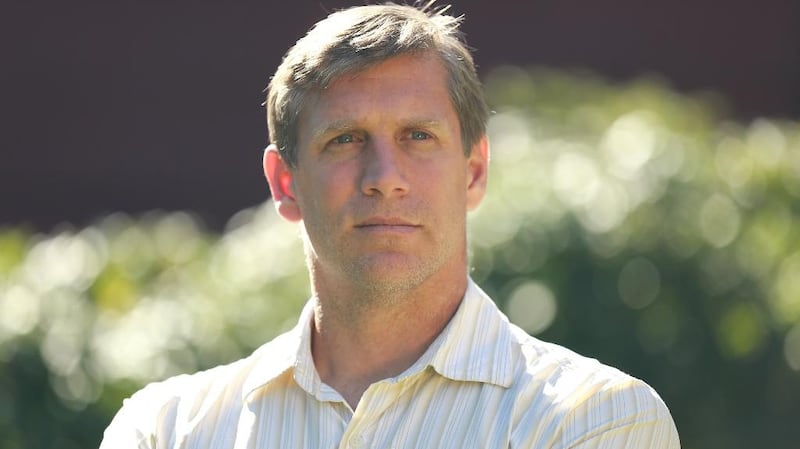Mark O'Connell has spent the past few years meeting people who want to upload their minds to robots and never die. He has visited warehouses filled with frozen heads, met people who implant technology in their own bodies, and toured the United States in a coffin-shaped camper van with a man who was campaigning to be president.

The general subject of O'Connell's beautifully written book, To Be a Machine, is "transhumanism". And far from being a fringe movement of online nuts, this is, in fact, at the centre of futurist thinking in Silicon Valley – Ray Kurzweil of Google is among its foremost theorists. The central tenet of transhumanism is the notion of the "singularity", a moment at which we will have both self-aware computers and the technology to allow us to merge our consciousness with machines. (Kurzweil has suggested the year could be 2045.)

O'Connell first came across transhumanism 10 years ago, when writing for the now defunct Mongrel magazine. He is, he stresses, a layman, not an expert, and he is even apologetic about describing himself as a journalist, despite writing for the New York Times magazine and the New Yorker's Page Turner blog. ("I'm emasculated by your professionalism," he says when he sees my uncharacteristically printed-out notes.)
“I guess I do have this weird obsession with the machine of the body,” O’Connell says as we upload sandwiches in a Dublin cafe.
"It’s almost a stoner philosophy. You sit around thinking, Am I just an object? Am I just a plate or a table? Transhumanism totally fits into that."
“While there is this quite extreme movement with a cluster of interesting ideas to think about in and of themselves, it’s also a kind of an extreme manifestation of our own f***ed-up relationship with technology and my own f***ed up relationship with being a fallible, dying human being.”
Instant obsession
So it's a way of writing about death? To Be a Machine, he says, "is a book about death. I didn't really realise it until Margaret Atwood put it on a list of her favourite books about death . . . I have this thing where anytime I go through a major life change it translates to instant obsession with death. When I got married I thought, The first part of my life is the part before I got married and I didn't die, and the second part is the part where I have been married and I die." He laughs. "I am morbidly preoccupied with death."
There was no better place for him to be, then, than Phoenix, Arizona, where Max More, chief executive of Alcor Life Extension Foundation, showed him a warehouse full of frozen heads.
“They call them ‘cephalons’,” O’Connell says. “They get a lot of mileage out of that euphemism. But it’s this really banal, mundane scenario. It’s an office where no one seems to be doing that much work. There’s a real air of lassitude about the place, and it’s literally in a business park beside a place called Big D Floor Covering Supplies.”
Is being frozen expensive?
"It would cost you $80,000 for just the head, which is the most popular option, and $200,000 for the whole body.” To pay for it “Alcor become the beneficiaries of your life-insurance policy”.
Those who sign up for this postdeath procedure do so in the hope that by the time they are unfrozen there will be a cure for death. “I think the preferred scenario is that you upload the brain into a new body, and the old fleshy body is disposed of. It’s a religious idea, basically. They hate that interpretation of it.”

In his book O'Connell can't help but reach for religious allegories. Still, he is reluctant to describe transhumanism as a religion (although he visits a quasi-religious offshoot, Terasem Faith). His narration has a winningly anxious air, and he indulges in long, entertaining tangents where he talks about philosophy, his young son and his own sanity.
Mad as he found some transhumanist ideas, he can’t entirely discount them. “I was often really aware of being the stupidest person in the room. I had this sensation of being around people who were way more rational than me and way more informed about the technologies. I used this phrase ‘magical rationalism’. There was a logic to everything, but it went to this space of craziness.”
A case in point: O'Connell spent time with a bunch of biohacking body-modification aficionados in a house on the edge of Pittsburgh. "They want to be cyborgs," he says. "They refer to themselves as 'practical transhumanists', and they're in an uneasy relationship with the people talking about mind uploading in the future. They want it now. They're like the DIY punk wing of the movement."
Practical transhumanists have unlicensed surgery to have technology implanted in their bodies. “So I’m a cyborg, but what does it mean? It means I can open my car without taking my keys out of my pocket. The cure is worse than the disease, basically. You have to get unlicensed surgery so you can open the door of your car without taking your key out. They saw it as a gesture towards the future.

"Again, there's a hugely religious dimension to it, but if you say that to them they get really impatient, because they're all hard-core atheists into Sam Harris and Daniel Dennett. "
Tim Cannon’s implant
Tim Cannon, the group's "de facto leader", recently had an implant removed that left a horrible scar on his arm.
“He’d had this thing about the size of a mobile phone in his arm,” O’Connell says.
"I saw it on a video. It was deeply sickening to look at. It took biometric measurements from his body, like a Fitbit but with much more accurate readings, and you had to get a surgeon" – in this case a "body modification artist" named Steve Haworth – "to put it into you . . . It uploaded information about body temperature to his laptop, which was connected to his heating system. If he got too cold the heat went on."
O’Connell laughs. “Kind of interesting, but also, would you not just get up and turn on the heating?”
Not everyone is drinking the Kool-Aid. Transhumanists ultimately believe that the mind is a vast collection of data that is replicable outside the body. But one sceptical neuroscientist told O’Connell that the brain is less like a collection of data and more akin to a shoal of fish. The notion that we might be able to upload to machines anytime soon is unrealistic.
It's a recurring "category error" that we humans make, O'Connell says: to assume that our minds are like the latest technology. "I think transhumanist ideas come from spending too much time with a computer and overidentifying with it as an extension of the self. It reminds me of The Third Policeman – the confusion between the man and the bicycle . . . I wonder if Flann O'Brien was around now, would he be writing about computers?"
In another chapter O'Connell travels with Zoltan Istvan, a transhumanist theorist and "life-size Ken doll", in a camper van designed to look like a coffin, as Istvan campaigns for the US presidency on an anti-death ticket.

"I like him against my better judgment," O'Connell says. The feeling must be mutual, because Istvan gave To Be a Machine a positive review on Amazon. He wrote, "I'm unaware of any other prominent writer having done so much research on the movement itself that was not a transhumanist."
How did all this contemplation of death and deathlessness affect O'Connell? "Hmm," he says and chews his sandwich. "This is 80 per cent chewing, 20 per cent thinking," he says after a while. He thinks again. The American political philosopher Francis Fukuyama "described transhumanism as the most dangerous idea in the world". O'Connell wouldn't go that far himself, but he says he understands the anxiety that comes from long-standing beliefs about what it means to be human. He writes movingly about his animalistic love for his wife and son:
"I don’t believe you can separate human existence from the body. We’re not a ghost in the machine.”
Would he like to be uploaded to a computer to live forever? “I would rather be dead. I can’t quite intellectually justify it, but it just feels viscerally nightmarish. Maybe I just don’t love life that much.”
His new friends in the world of transhumanism would call this a “deathist” philosophy. It is an outlook he couldn’t even shake when faced with a minor cancer scare. “I think my view of death is still the view of a guy in his mid-30s. Whereas I talk to my dad about it, he’s 73 and he has a completely different view. He’s a pharmacist, and says maybe it wouldn’t be such a terrible thing. You get to my age and an extra few years would be nice. I suppose it’s difficult to imagine being at a point where you’re like, time’s up.”
Transhumanists, on the other hand, don't talk in terms of an extra couple of years. Many fantasise about travelling the universe eternally as near god-like machines. Meanwhile, scientific types such as Elon Musk and Stephen Hawking warn of the dangers posed by malevolent artificial intelligences.
“There’s a sense that these people are off the reservation,” says O’Connell, “but at the same time these are the people creating the future. Fifty years ago, if you had people talking about how we were all going to spend all our time in this semi-imaginary, semi-real realm” – the internet – “we’d think that’s mad, and it doesn’t sound all that great.”
Who owns the servers?
O’Connell’s current concerns are more prosaic. He worries about who owns the servers on to which our data and personalities might be uploaded (few transhumanists fret about such things) and, in the shorter term, about his son’s employment prospects.
“The one thing I came out of writing this book completely shitting myself about was the employment implications of this technology.” The destruction of jobs, he says, will happen soon.
“In the same way that the book is about death and America, it’s about capitalism as well. I feel like the logic of capitalism is inexorably heading towards owning the means of production and the labour force, and integrating that into one machine and getting rid of as many people as possible.”
Ultimately, To Be a Machine is both an insight into transhumanist thought and O'Connell's very relatable fears and anxieties about mortality and the future. I assume he will follow through on these in his next book, which is about prepping for the fall of civilisation: "It's always the apocalypse one way or another."
His son recently asked what happens when people die. Without a religious afterlife to fall back on, his mother told him that his father was writing about people who believed that death would end, so he might never have to worry about it.
"And it worked. It was a perfect microcosm of why these ideas are so powerful. It defused the tension around death.”
O’Connell laughs. “Also, it was perfect for the book.”
Patrick Freyne is interviewing Mark O'Connell as part of the Mountains to Sea DLR Book Festival, at the LexIcon in Dún Laoghaire, on Saturday, March 25th, at 7pm; mountainstosea.ie. To Be a Machine: Adventures Among Cyborgs, Utopians, Hackers, and the Futurists Solving the Modest Problem of Death is published by Granta Books













